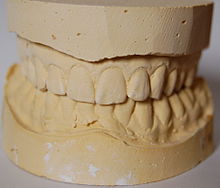- Impression (dental)
-
A dental impression may be described as an accurate representation of part or all of a person's dentition and other areas of the mouth. The dental impression forms an imprint (i.e. a 'negative' mould) of those teeth and gums, which can then be used to make a cast or 'positive' model of the dentition. This may be used for the fabrication of dentures, crowns or other prostheses and orthodontics.
An impression is carried out by placing a viscous liquid material into the mouth, usually in a customised dental impression tray. The material, usually an alginate, then sets to become an elastic solid, and, when removed from the mouth, provides a detailed and stable reproduction of teeth. Common materials used for dental impressions are sodium alginate, polyether and silicones - both condensation-cured silicones and addition-cured silicones, such as polyvinyl siloxane. Historically plaster of Paris, zinc oxide eugenol and agar have been used.
See also

This dentistry article is a stub. You can help Wikipedia by expanding it.

